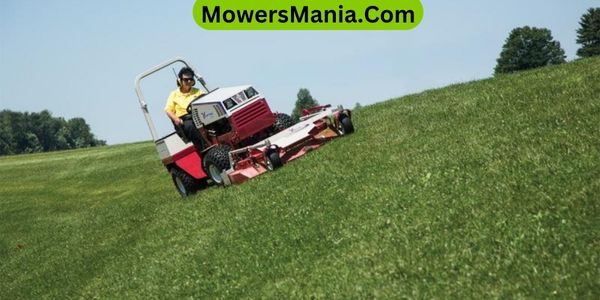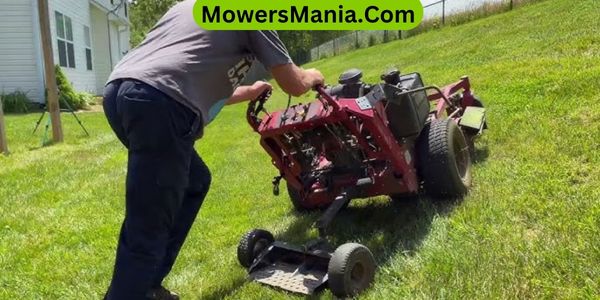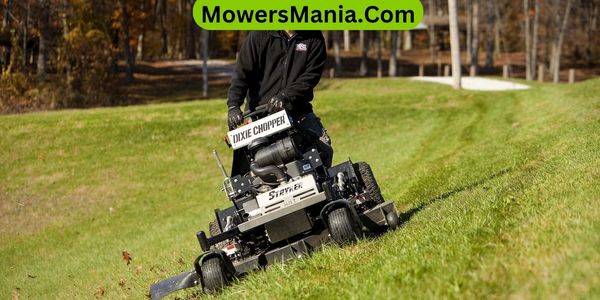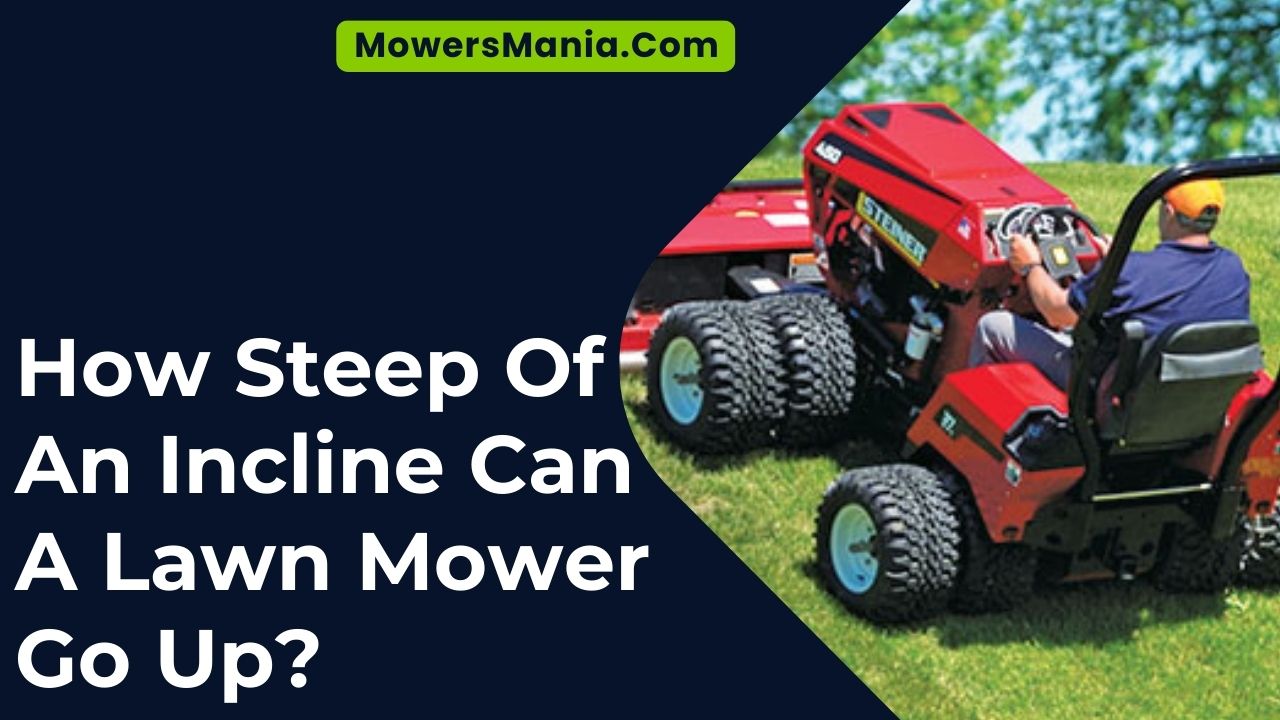You’re wondering how steep of an incline your lawn mower can handle. It all depends on the type of mower, its engine power, and the terrain.
Factors like traction, weather, and safety also play a role. Let’s explore the capabilities and limitations of lawn mowers on inclines.

Types of Lawn Mowers
When choosing a lawn mower, it’s important to consider the incline of your yard and the specific capabilities of each type of mower. For flat or gently sloping yards, a traditional push mower or a self-propelled mower could be suitable options.
These mowers are easy to use and maneuver, making them ideal for yards with minimal incline. However, for steeper inclines, a riding mower or a specialized hillside mower may be more appropriate.
Riding mowers offer convenience and are suitable for larger yards with varying terrain, while hillside mowers are specifically designed to tackle steep slopes with stability and control.
Another option to consider is the robotic mower, which is gaining popularity for its ability to handle inclines and uneven terrain with ease.
These autonomous mowers can navigate inclines and complex yard shapes, making them a convenient choice for homeowners with challenging landscapes.
Additionally, they operate quietly and can be programmed to mow at specific times, providing a hands-off lawn care solution.
Understanding the incline of your yard is crucial in selecting the right type of lawn mower to ensure efficient and safe mowing.
Engine Power and Torque
You frequently rely on the engine’s power and torque to handle steep inclines when mowing your lawn. The engine’s power and torque play a crucial role in determining how well your lawn mower can tackle inclines.
Here’s what you need to know about engine power and torque:
- Power Output: The engine’s power output, typically measured in horsepower, determines the strength and speed at which the lawn mower can propel itself up inclines. More horsepower generally means better uphill performance, especially when dealing with thick or tall grass.
- Torque: Torque is equally important as it measures the engine’s ability to maintain consistent power and rotational force, which is essential for climbing steep slopes. Higher torque allows the mower to handle inclines more effectively without stalling or slowing down.
- Transmission Type: The type of transmission in your lawn mower can also significantly impact its ability to navigate inclines. Hydrostatic transmissions provide smoother and more precise control, making it easier to manage uphill climbs compared to manual transmissions.
Understanding the engine’s power and torque, as well as the type of transmission, can help you choose a lawn mower that’s well-equipped to handle the inclines in your yard.
Terrain and Slope Conditions
When mowing on slopes, it’s important to consider the maximum slope for safe operation and the potential risks involved.
Safety on steep slopes is crucial, and understanding how terrain and slope conditions can impact your lawn mower’s performance is essential.
Keep in mind these points as you navigate different terrain and slope conditions to ensure a safe and effective mowing experience.
Maximum Slope for Mowing
Mowing on slopes requires careful consideration of the terrain and slope conditions to ensure safe and effective operation.
When determining the maximum slope for mowing, keep in mind the following:
- Slope Gradient: The maximum slope for mowing typically ranges from 15 to 20 degrees. Beyond this, the risk of tipping or losing control of the mower significantly increases.
- Terrain Stability: Assess the stability of the terrain, taking into account any uneven ground, holes, or obstacles that could affect the mower’s traction and stability.
- Weather Conditions: Consider the impact of weather conditions on the slope, such as wet grass or rain, as these factors can make the slope more hazardous for mowing.
Safety on Steep Slopes
Considering the terrain stability and slope conditions, assess if the lawn mower can safely handle the incline.
When dealing with steep slopes, it’s crucial to prioritize safety. Ensure that the terrain is free from obstacles such as rocks, branches, or holes, which could pose a danger to both the operator and the equipment.
Additionally, evaluate the slope conditions, taking into account the type of grass, soil moisture, and any potential water runoff. These factors can significantly impact the stability of the mower and the operator’s ability to maneuver safely.
If the slope is too steep or the terrain is unstable, it’s best to avoid mowing these areas altogether to prevent accidents and equipment damage.
Always prioritize safety when operating a lawn mower on steep slopes.
Traction and Wheel Design

To ensure your lawn mower can effectively navigate steep inclines, it’s essential to consider the traction and wheel design. The traction and wheel design play a crucial role in determining how well your lawn mower can handle steep inclines.
Here are a few key factors to consider:
- Tread pattern: The tread pattern of the lawn mower’s wheels significantly impacts its traction on inclines. Tires with deeper, more aggressive treads provide better grip and traction, especially on steep slopes. It’s essential to choose a tire tread pattern that’s specifically designed to handle inclines to ensure optimal performance.
- Wheel size: The size of the wheels also affects the mower’s ability to navigate inclines. Larger wheels generally provide better stability and traction on uneven terrain, including steep inclines. They can help prevent the mower from losing traction and slipping on steep slopes.
- Wheel material: The material of the wheels can impact traction as well. Opt for wheels made from durable materials that offer good grip on various surfaces, including steep inclines. High-quality, grippy wheel materials can enhance the overall traction and performance of the lawn mower on inclines.
Considering these factors when evaluating the traction and wheel design of a lawn mower can significantly improve its ability to navigate steep inclines.
Weather Impact
You need to consider the impact of weather on your lawn mower’s performance.
Slope and traction can be affected by wet grass or rain, making it harder for your mower to climb inclines.
Stability factors also come into play, as wet conditions can affect the overall stability of the mower on steep slopes.
Slope and Traction
Your lawn mower’s ability to navigate steep inclines depends on the slope and traction, especially when weather conditions impact the terrain.
When considering slope and traction, there are several key factors to keep in mind:
- Slope Angle: Steeper inclines require more traction for the lawn mower to navigate without slipping. As the angle of the slope increases, the demand for traction also rises significantly.
- Tire Tread: The design and condition of your mower’s tires play a crucial role in maintaining traction. Tires with deeper treads provide better grip on uneven or slippery terrain.
- Weather Conditions: Wet or muddy surfaces can drastically reduce traction, making it more challenging for your lawn mower to tackle steep inclines. Keep an eye on the weather forecast and avoid mowing on excessively wet or slippery slopes to ensure safety and optimal performance.
Grass and Rain
When mowing on steep inclines, it’s important to consider the impact of rain on the grass’s traction. Wet grass can significantly reduce the traction between the lawn mower’s wheels and the ground, making it more difficult to navigate inclines.
Additionally, rain can soften the soil, increasing the risk of the lawn mower slipping or getting stuck. To mitigate these risks, consider mowing the lawn before the rain or allowing the grass to dry out after a downpour.
You may also want to choose a mower with wider wheels for better traction or consider using a self-propelled mower for added control.
Ultimately, being mindful of weather conditions and their impact on grass traction can help ensure safer and more effective mowing on inclines.
Mower Stability Factors
Consider the impact of weather conditions, such as rain and soil moisture, on the stability of your lawn mower when navigating steep inclines. These factors can significantly affect the performance and safety of your mower.
Here’s how weather can impact mower stability:
- Wet Grass:
Rain can make the grass wet and slippery, reducing the traction of the mower’s wheels and potentially causing it to slide on inclines.
- Soil Moisture:
Moist soil can make the ground softer, increasing the risk of the mower losing traction or even getting stuck on steep slopes.
- Wind:
Strong winds can affect the balance and control of the mower, especially on steep inclines, posing a potential safety hazard.
Being mindful of these weather-related factors is crucial for maintaining stability and safety when operating a lawn mower on inclines.
Safety Considerations

Make sure to assess the slope’s angle and the mower’s stability before attempting to mow on inclines. Safety should always be a top priority when mowing on inclines.
It’s important to evaluate the steepness of the slope before starting the mowing process. Steeper inclines can pose significant safety risks, so it’s crucial to determine whether the slope is within the mower’s capabilities.
Before mowing on inclines, check the manufacturer’s guidelines to ensure that the specific model of your mower is designed for the slope’s angle. If the slope is too steep for your mower, it’s best to avoid mowing it altogether.
Additionally, inspect the mower’s stability on inclines. Ensure that the tires have proper traction and that the mower won’t tip over during operation. Clear the area of any obstacles, such as rocks or branches, before mowing.
Always walk the incline first to identify any potential hazards and to plan the mowing path. By taking these safety considerations into account, you can help prevent accidents and maintain a safe mowing environment.
Frequently Asked Questions [FAQs]
Can a Lawn Mower Be Used on a Steep Incline Without Causing Damage to the Engine or Other Components?
You can use a lawn mower on a steep incline, but it may cause engine damage if the angle is too steep. It’s essential to check your mower’s manual for the recommended incline limits to avoid potential issues.
What Are the Potential Risks of Using a Lawn Mower on a Steep Incline, and How Can They Be Mitigated?
When mowing on a steep incline, the potential risks include loss of control, tip-over, and damage to the engine. To mitigate these risks, ensure your mower has a low center of gravity and traction tires.
Are There Specific Lawn Mower Models or Brands That Are Better Suited for Use on Steep Inclines?
You should consider specific lawn mower models or brands better suited for steep inclines. Look for ones with sturdy engines, good traction, and built-in safety features. Research and compare different options before making a purchase.
How Does the Weight of the Lawn Mower Affect Its Ability to Navigate Steep Inclines?
The weight of the lawn mower significantly affects its ability to navigate steep inclines. Heavier mowers may struggle on steep slopes, while lighter models can handle them better. Consider this when choosing a mower for incline mowing.
Are There Any Special Maintenance or Care Considerations for Lawn Mowers Used on Steep Inclines?
When mowing on steep inclines, it’s important to regularly check the oil, air filter, and blade condition. Also, keep the tires properly inflated and adjust the mowing speed to maintain control. These steps will help ensure safe and efficient mowing.
Conclusion
So, when considering how steep of an incline your lawn mower can handle, it’s important to take into account the following factors:
- The type of mower
- The engine power and torque
- The terrain and slope conditions
- Traction and wheel design
- Weather impact
Always prioritize safety and be mindful of the slope you’re mowing on to ensure the best performance of your lawn mower.



